Valentine’s Day has long been associated with gestures of love and affection, both big and small. From carcinogenic conversation hearts and mass-produced cards with cartoon characters of our early years, to the elegant boxes of chocolate and grand declarations of love that the media normalizes today, it has been ingrained in minds young and old that this holiday is a day to show our appreciation for the company we keep.
Integral to these celebrations is the flower: a universal symbol of beauty and appreciation. But why flowers? How have these delicate blossoms come to symbolize humanity’s adoration for one another? In the earliest human grave sites, remnants of flowers have been found, showing that this tradition is not merely the result of advertising and corporate greed, but rather a custom that has grown and evolved just as humans have. By taking a look at the history of flowers, then evaluating the influence of flowers in modern times, these questions can be answered, as well as the question likely on the minds of prospective bouquet-givers: what is the perfect bouquet to give?

Flowers have served as a form of social interaction for as long as we can remember. Moreover, the Greeks utilized flowers as representations of certain deities, allowing flowers to be used as symbols up into the middle ages. While most popular in Europe among the French and English, assigning meanings to flowers has been attributed to Turkey. Unsurprisingly, the tradition of flower-giving carried onto the Victorians. With talking as a way of expressing being frowned upon, flowers were a great opportunity to communicate. Several practices from this era are now out of practice. For example, if a bouquet of roses from a florist is given upside down, the receiver would surely be upset. This is because red roses were thought to symbolize anger if gifted when upside down. The Roman goddess Flora, whose name one may recognize from the term for a population of plants in a given area, is the deity of flowering plants. Her head was the face of Roman coins, adorned with a flower crown. 238 B.C.E saw the establishment of her statue, and 240 B.C.E introduced her festival, Floralia. Floralia was held around April 28 through May 3. It represented the resurgence of the life cycle, flowers, and drinking. The studied remnants of humanity’s paleolithic origins have shown a use of flowers, even then. Notably, celebrations and feasts of the dead among notions about fertility, especially in connection with the growing and ripening of cultivated plants, have shown ideas and traditions that often had flowers used. In northern Iraq stands the Zagros Mountain range, and within it, the Shanidar Cave. The Shanidar Cave is home to what is currently the oldest discovered site of ritualistic burials by Neanderthals. In 1960, Shanidar 4 was uncovered in the fetal position with notable pollen samples found within the soil analyses. This discovery prompted the idea that flowers may have been purposefully buried with Shanidar 4 when he had passed. Moreover, the yarrow, cornflower, bachelor’s button, Barnaby’s thistle, ragwart, grape hyacinth, horsetail, and hollyhock were all medicinal plants and pointed to the possibility that Shanidar 4 had been a medicine man of some sort. However, this speciation has been retired due to findings of rodent remains that suggest natural carrying of seeds and vegetation to the site. With hygiene, waste disposal, and plumbing not being in its evolved state as it is today, it can be said that the previous centuries had an unpleasant scent to them. The contents of chamber pots were often thrown out into the street and people did not bath often due to a lack of access. At this time, disease breathed down the necks of the population and medicine was not always readily avalible, especially to those lower than middle class, and left the dead in the street where they were until taken off. All that being said, it’s unsurpising that people found ways to cover the scent of the city. This often included more pungent flowers, like roses. During the Middle Ages in Europe, a common sight was the “bird” masked physicians who roamed the most infected neighborhoods. A plague doctor worked during epidemics, often requested by the government to care for areas effected the most by the then-present illness, whatever it may have been in that given circumstance. Their beaked mask held strong herbs and flowers with the belief of warding off illness, often including myrrh, lavander, and/or mint.

The symbolic prevalence of flowers isn’t limited to far-away countries, however—our own community is rife with the pervading influence of flora. Just last month, the Saint Cecilia Cathedral hosted its 39th annual Flower Festival, where the Omaha community enjoys the spectacular floral arrangements made by local florists, all while listening to musical accompaniments also supplied locally. One of these musicians, Brownell Talbot’s own Christopher Palo, shared his experience in an interview. This was his second time supplying sacred Greek chants for the event, and he expressed his admiration for the venue. “Any time to go to Saint Cecilia is a treat,” Mr. Palo recounted, “and the acoustics are wonderful.” Once he had finished performing, Mr. Palo took a look at the myriad flowers on display, of which he had beaming praise for. In particular, he noticed the saturation of roses in many of the pieces. When asked why that may be, Mr.Palo responded, “They’re an all-purpose deal. Roses tell people, ‘Hey, miss you, love you, thinking of you…’ Everyone knows the rose.”
On the topic of the significance of flowers, Mr. Palo had several helpful insights as to why these beautiful blossoms carry such significance to humans: “Flowers mimic people. They both emerge from the soil, from nothing, live for a brief period of time, then return to nothing. Flowers bring you a lot of joy, even if only for a split second.” Among his reasons was also the paradox that even though individual blossoms last only a fraction of a person’s life, the concept of flowers is perpetual. “We take them for granted when they come out of the ground,” Mr. Palo mused. For many, this sense of stagnation is what connects flowers to their childhood, first love, or other nostalgic moments in one’s life. This theme was exhibited in the types of people that attended the festival, most of whom were older women. One woman in particular, Mr. Palo recounted, went to the festival for the first time without her husband, who had recently passed away. She had returned to the festival since the flowers reminded her of him, and allowed her to reminisce about the previous memories they had made at past festivals. Also in attendance were younger women, men, and children, all of whom greatly appreciated the displays for reasons distinctly personal and unique to their own lives.
Since individuality and nostalgia is such a driving factor for the popularity of flowers, many careers involving floral arrangements have had to adapt to this uniqueness. Andrea Ramsey, a former florist for 15 years who has created arrangements for hospitals, weddings, and funerals, understood this concept, which is why her floral business created custom arrangements for special occasions. While practicing this art, Ms. Ramsey was able to make a general guide for each bouquet. First, the client would select a vase, then choose the flowers to place into it. Ms. Ramsey would then accentuate with non-flowering greenery, or what she calls “stuffing,” to give the arrangement more volume.

Some of her arrangements give her more freedom, such as those whose clients merely request a specific color scheme, but can also be hyper-specific, such as with important events like weddings. No matter the occasion, however, Ramsey has the ability to mix and match myriad flowers to create the most visually appealing flowers, no matter the occasion. Along her journey, Ms. Ramsey has learnt many tricks of the trade. One rule of floral arrangements, in particular, stood out to her: the usage of “funeral flowers.” According to Ms. Ramsey, funeral flowers are heavily associated with death and somber occasions, and should thus seldom, if at all, be used in other bouquets. A common feature of a funeral flower is its ability to make a presence, or to take up a lot of space. Some examples of these flowers are calla lilies, chrysanthemums, and gladiolas. Gladiolas especially, Ms. Ramsey stressed, had strong ties to death. “Everyone associates that flower with funerals,” she remarked, “so you don’t really see them anywhere else.”

Most people Ms. Ramsey served, though, wouldn’t have known about funeral flowers or other flower rules, and were instead governed by a wholly separate law: money. Ramsey stressed the importance of creating arrangements of all price points, especially in fields as delicate as funeral arrangements. “You don’t want to spend a lot of money in the hospital,” Ms. Ramsey explained. Verily, the act of giving flowers to a sick friend or relative should be a thoughtful gesture that fosters joy, not one that breaks the bank. Ms. Ramsey agreed, recounting her goal for each arrangement: “I try to do happy colors. Bright colors. Flowers are supposed to bring you happiness.” True to her word, many sought out Ms. Ramsey’s services, mostly in the form of young men seeking to woo their partners or older women entrusting Ms. Ramsey to prepare the perfect wedding bouquet. Either way, it is clear through Ms. Ramsey’s account that the art of flower arrangement is still alive and thriving.
With all that being said, the essential question posed at the beginning of this article has yet to be answered: What is the perfect bouquet? The short answer is that there isn’t. Not for everyone, at least. The act of giving flowers is so personalized that every single person will interpret in different ways. A dozen roses might symbolize love for one, but heartbreak for another. That isn’t to dissuade people from giving flowers, however—-much the opposite. By giving someone you care about a bouquet that speaks to how well you know them as an individual, through the color scheme, amount of stems, and flower choice, you have the ability to deepen a bond with the people you care about. Much as Mr. Palo said, flowers act as a reminder that someone loves you, cares about you, or thinks about you. To go through lengths to find out someone’s favorite color or flower, then presenting the proof that you remembered in the form of beautiful blossoms, is an experience sure to establish a connection, or strengthen an existing one. As such, small gifts like flowers, chocolates, and cards serve not as a grandiose gesture of affection and admiration, but as a small token of appreciation and gratitude in return for brightening your life. After all, flowers, as we have seen, are a symbol for brightness in a world that can often seem dark. Giving these sources of happiness to another source of happiness seems only natural—expected, even. So, on this Valentine’s Day, spread this brightness to your loved ones, whether it be family, a friend, or a significant other, and give them the gift of caring.
















